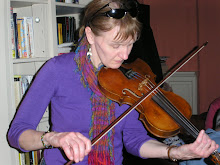
We started at the Paisley City Museum. This is a free museum and the oldest municipal museum in Scotland. It houses one of the best collections of Paisley shawls in the world. The collection curator, Valerie Reilly, gave us a detailed talk and slide presentation of the history of the Paisley shawl from the design's origins in Babylon where it was a fertility symbol, how it spread to the Kashmir region of India, and then finally to Europe. The East India company started importing them to Europe in 1780.
Originally the shawls coming from Kashmir were made of pashmina goat fiber that was collected bushes where the goats would rub it off. These shawls were woven on simple wooden looms and took months to weave. The limited source of the fiber and the time it took to weave these shawls in Kashmir made them very expensive. Josephine, Napolean's wife, had 200 shawls in her wardrobe. By the late 1700's the shawls were being produced in Edinburgh, Norwich, France, Russia and Paisley on draw looms. Paisley had highly skilled weavers who had previously woven linen.
The town of Paisley in the height of popularity of the Paisley shawls around 1840, had hundreds of weavers making these wonderful cloths, then on the Jacquard loom. An elaborate paisley design could take 484,000 pattern cards to produce it. But the weavers had to be accurate in their weaving, so that by the time they had woven an entire shawl pattern, they were within 1/4" of the required length.
The paisley pattern changed throughout the 100 years the shawls were in fashion. The designs became more elongated in the Victorian era. The size of the shawls also changed as women's fashion changed. In the 1850's, the shawls were woven 5' 6" x 11' so they could be folded and used like a coat to fit over crinoline skirts. When the bustle came into fashion 1865-1870, this was the death of the paisley shawl as the shawls didn't work with the protruding bustle shape. http://www.renfrewshire.gov.uk/
 Sma Shot Cottages are just down the road. The name Sma Shot comes from the binding weft thread that was thrown every 7th pick to hold the rest of weft threads in place in the paisley fabric. A society has resurrected and preserved one of the weavers cottages from the era when linen was woven Paisley, (1700's) and then other rooms depicting life in later years.
Sma Shot Cottages are just down the road. The name Sma Shot comes from the binding weft thread that was thrown every 7th pick to hold the rest of weft threads in place in the paisley fabric. A society has resurrected and preserved one of the weavers cottages from the era when linen was woven Paisley, (1700's) and then other rooms depicting life in later years.The men were the weavers, but there were many other jobs associated with making the shawls including designers, beamers, warpers, washers, steam pressers, stenters, fringers, and then the marketers. The weaver took an oath to eat his shuttle rather than give away trade secrets. Thus the shield for the weaver's trade has 3 tabby cats on it with shuttles in their mouths. Their motto was "Weave Truth with Trust" The first Saturday of July, is "Sma Shot Day", still celebrated. This commemorates the day in 1856 when the weavers won the case to be paid for the yarn used to weave the "sma shot."
After our tour and a fine lunch in the tea room, we treated the volunteers to our version of Danny Kyle's song, "The Music of the Loom." After just one day of practice the travelers heartily joined me on the chorus " pee nickle, po nickle a' roon the toon it's heard, pee nickle po nickle music o' the loom" http://www.smashot.co.uk/
 The Thread Mill museum tells the story of the huge thread industry in Paisley that shut the last door in 1992. The Coats and Clark company which was a combination of the Anchor Thread Mill and the Ferguslie thread mill at one time produced 90% of all the thread made in the world. The cases display mile reels of thread, posters, memorabilia from mill workers, and now all the photographs have been digitalized and are displayed on a large plasma screen. Most of the volunteers who run this museum worked in one of the mills.
The Thread Mill museum tells the story of the huge thread industry in Paisley that shut the last door in 1992. The Coats and Clark company which was a combination of the Anchor Thread Mill and the Ferguslie thread mill at one time produced 90% of all the thread made in the world. The cases display mile reels of thread, posters, memorabilia from mill workers, and now all the photographs have been digitalized and are displayed on a large plasma screen. Most of the volunteers who run this museum worked in one of the mills.http://www.paisleythread.org/

A quick stop at Paisley Abbey concluded our day in this town, just a 20 minute train ride from Glasgow. The 12th century abbey has a medieval nave. The monestary was disbanded in 1560 and the central tower of the abbey collapsed in the same century. Restoration start
 ed in the 19th century and continued into the 20th century. The stained glass windows all have interesting stories, described in a pamphlet available at the entry. The abbey also houses Royal Tombs including Marjory Bruce, the daughter of Robert the Bruce. www.paisleyabbey.org.uk
ed in the 19th century and continued into the 20th century. The stained glass windows all have interesting stories, described in a pamphlet available at the entry. The abbey also houses Royal Tombs including Marjory Bruce, the daughter of Robert the Bruce. www.paisleyabbey.org.uk

No comments:
Post a Comment